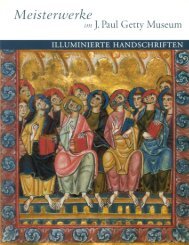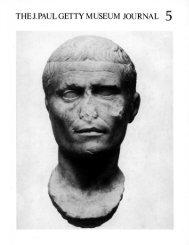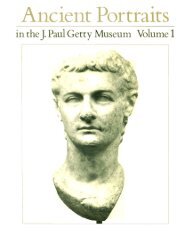The J. Paul Getty Museum Journal Volume 15 1987
The J. Paul Getty Museum Journal Volume 15 1987
The J. Paul Getty Museum Journal Volume 15 1987
You also want an ePaper? Increase the reach of your titles
YUMPU automatically turns print PDFs into web optimized ePapers that Google loves.
50 Cassidy-GeigerFigure 13. Ignaz Preissler (Bohemian, 1676—1741). Platedecorated with a putto in the guise of a rivergod, circa 1725. Schwarzlot and gold decoration.Formerly Berlin, von Dallwitz collection;present location unknown. Photo: CourtesyVerlag Anton Hiersemann, Stuttgart.Figure 14. Municipal diploma issued to Michael Steinmetzon February 26, 1678. Augsburg, 1678.Sepia ink on parchment, heightened withgray wash and gold leaf. H (fully opened):64.5 cm (25 3 / 8"); W: 68 cm (26 3 / 4"). Cologne,Bundeszahnärztekammer. Photo: CourtesyBundeszahnärztekammer, Cologne.gold with figures representing the months after Hans-Sebald Beham (<strong>15</strong>00—<strong>15</strong>50), the inner circular border enclosesa wreath of fruit or flowers (fig. 7). 34<strong>The</strong>sesaucers are presently in the UmeleckoprümysloveMuzeum in Prague (18.959) and in the British <strong>Museum</strong>(Franks Coll. 124).Preissler's oeuvre includes other allegorical themesand cycles as well, such as the elements, the continents,and the months. A saucer obviously from a serviceillustratingthe latter is decorated with a hunting allegoryrepresenting November (fig. 8). 35<strong>The</strong> image derivesfrom a <strong>Paul</strong> Decker design engraved by Martin Engelbrechtand published in Augsburg by JeremiasWolff(fig. 9). Comparison of the scene on the saucer to theimage in the engraving illustrates again how Preissleradds his own elements to the scene to make it betteraccommodate the circular surface. In this case, a zodiacsign has been employed to identify the subject; a tree isused to anchor the figure in the foreground; and backgrounddetails enhance the recession of space. Many of34. Dr. Dagmar Hejdovä and Dr. Olga Drahotovä deserve specialmention here for their generous assistance, support, and hospitalityduring the many days that I was permitted to study the collection inthese allegorical works date from the Breslau period,but the "difficult poetic subjects" described in theKronstadt invoices indicate that allegorical subjects werestill requested by the artist's patrons later in his life.<strong>The</strong> <strong>Getty</strong>'s leaf-shaped dish of Meissen porcelainadapted from a blanc-de-chine model and painted in ironredwith gold highlights represents another populartheme from Preissler's Breslau period (figs. 10a—e). <strong>The</strong>dish is decorated on the inside with a winged puttoholding a marsh reed and seated backwards on a dolphinlikesea dragon with a spiraling tail. <strong>The</strong> inside rimshows Preissler's characteristic form of Laub- und Bandwerk.On the outside, strapwork and foliate scrollscourse around the sides sprouting leaves and tendrils.Amoretti, fountains, baskets of fruit,and birds areperched among the scrollwork. <strong>The</strong> leafwork in reliefon the underside is outlined in iron-red and gold.Some of the many similarly decoratedleaf-shapeddishes in various museums are painted like this one iniron-red with gold, and others are painted in a corn-Prague. I wish also to thank Aileen Dawson of the British <strong>Museum</strong>for allowing me to see this piece and others in storage.35. Pazaurek (supra, note 3), p. 219, fig. 181.








